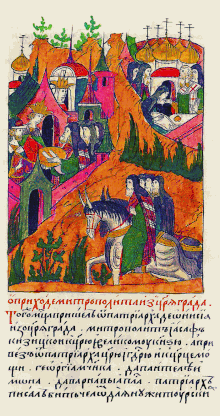Dionysius II of Constantinople
Dionysius II | |
|---|---|
| Ecumenical Patriarch of Constantinople | |
 Dionysius II sending Joasaphus, metropolitan of Cyzicus, as ambassador to Ivan IV of Russia | |
| Church | Church of Constantinople |
| Elected | 17 April 1546 – July 1556 |
| Predecessor | Jeremias I |
| Successor | Joasaph II |
| Previous post(s) | Metropolitan of Nicomedia |
| Personal details | |
| Born | unknown |
| Died | July 1556 |
Dionysius II (Template:Lang-el), (? – July 1556) was Ecumenical Patriarch of Constantinople from 1546 to 1556.
Life
Dionysius was born in Galata (now part of Istanbul).[1] In 1516[2]: 186 he was appointed Metropolitan of Nicomedia and he was consecrated bishop by Patriarch Theoleptus I.[1]
Dionysius was designed by Patriarch Jeremias I as his successor, and, after Jeremias' death, he was actually elected on 17 April 1546[2]: 39 supported by popular manifestations and against the hopes of the Holy Synod.[3] During his Patriarchate he was blamed for having raised the appointment fee (peshtesh) due to the Ottoman Sultan to three thousand Écus and for the demolition, ordered by the Sultan, of the great cross on the roof of the Pammakaristos Church, at the time the seat of the Patriarchate.[4]
The more significant event of his patriarchate was the 1546 travel in Italy of the young Metropolitan of Caesaria, Metrophanes, who years later would become Patriarch. Dionysius sent Metrophanes to Venice mainly to raise funds, but Metrophanes went also to Rome and met the Pope. In 1548 these news caused a great concern in a part of the Greek population of Constantinople, with riots and an attempt to murder Dionysius, who was considered as guilty as Metrophanes.[5] Dionysius was on the point of being deposed, but no actions were taken against him because he enjoyed the support of Suleiman the Magnificent.[6]
Dionysius reigned until he died. The date of his death is disputed among scholars, and various dates have been proposed, such as 1554 and 1555, but the correct date seems to be July 1556,[2]: 46 a conclusion supported by Venetian documents.[5] He was buried in the Kamariotissa Monastery on the island of Chalki.[1]
References
- ^ a b c "Dionysios II". Ecumenical Patriarchate. Retrieved 18 June 2011.
- ^ a b c Kiminas, Demetrius (2009). The Ecumenical Patriarchate. Wildside Press LLC. ISBN 978-1-4344-5876-6.
- ^ Runciman, Steven (1985). The Great Church in captivity. Cambridge University Press. p. 199. ISBN 978-0-521-31310-0.
- ^ R. Janin (1956). "Costantinople, Patriarcat grec". Dictionnaire d'histoire et de géographie ecclésiastiques. Vol. 13. Paris: Letouzey et Ané. 677.
- ^ a b Moustakas Konstantinos. "Dionysios II of Constantinople". Encyclopaedia of the Hellenic World, Asia Minor. Archived from the original on 17 September 2011. Retrieved 18 June 2011.
- ^ Frazee, Charles (2006). Catholics and sultans : the church and the Ottoman Empire, 1453-1923. London: Cambridge University Press. p. 29. ISBN 0-521-02700-4.
Sources
- Frazee, Charles A. (2006) [1983]. Catholics and Sultans: The Church and the Ottoman Empire 1453-1923. Cambridge: Cambridge University Press.
{{cite book}}: Invalid|ref=harv(help)
